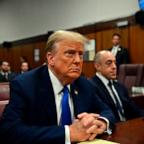Balloonatics Prepare for Thanksgiving Parade
Nov. 23, 2004 — -- Talk about inflated egos: When it comes to consuming helium, Macy's is second only to the federal government, and it's all on account of Big Bird, Garfield and other balloon celebrities.
It will take 400,000 cubic feet of helium to blow up the 16 giant balloons and other attractions featured in this year's Macy's Thanksgiving Parade.
The new cast of giant balloons features a 62-foot-tall SpongeBob SquarePants as well as an extra-large Chicken Little, who will require 50 wranglers to keep him from flying the coop.
The M&M characters have also been balloonified for the first time. The red and yellow corporate mascots have forgone their usual chocolate filling for 13,335 cubic feet of helium as part of a 50-foot attraction.
The 78th annual Macy's Thanksgiving Day Parade kicks off at 9 a.m. Thursday, marching 2½ miles down Manhattan, from West 77th street, through Columbus Circle and down Broadway to -- where else? -- Macy's flagship department store at Herald Square.
Marching bands from all over the country, floats celebrating everything from Barbie to the Weebles, not to mention stars such as Hilary Duff and American Idols Ruben Studdard and Clay Aiken, will be joining in on the fun.
But it's hard to eclipse the shear magnitude of the giant balloons. The beak alone on Big Bird is 13 feet long.
These balloons -- once rubber, now polyurethane -- have been a Thanksgiving tradition since the earliest years of the parade, but they remain a source of wonder.
If you're watching this event with a kid -- and that's the best way to watch any parade -- here's a handy timeline that just might help explain how America's most famous parade took off, what happens to old balloons when it's time to retire, and what keeps these airborne behemoths from spinning out of control.
1924: Lions and Tigers and Clowns, Oh My
In the first parade, horse-drawn floats carried real lions and tigers through Manhattan. Macy's employees marched through the streets dressed up as cowboys, clowns, Arab sheiks and knights in armor. On the last float -- where you can still find him -- rode Santa.
Back in 1924, Macy's never imagined that its holiday parade -- originally dubbed the Macy's Christmas Parade -- would be anything more than a holiday party for its staff. Crowds lined the streets, however, and that's when management saw its potential to kick off the holiday shopping season.
To avoid confusion, Macy's changed the parade's name. Santa remained the star, but the wild animals scared some kids. That's bad for business. What attraction could please everybody? How about giant, colorful balloons shaped like animals?
Thus, Felix the Cat -- and eventually Mickey Mouse and Garfield -- replaced critters from the Central Park Zoo to become America's ultimate party animals.
1927: Up, Up, and Away in an Exploding Balloon
The first parade balloons were filled with air and carried through the streets. Then, in 1927, helium came along, and it was an instant sensation, giving the world, among other things, the first 50-foot inflatable hummingbird.
At the parade's finale, someone had a really novel idea -- what if the giant balloons got to go free? Parade organizers decided to liberate 10 balloons into the skyways.
Unfortunately, helium expands with altitude. One by one, four of the balloons exploded -- even before they could pass the top of the Empire State Building. Among the casualties: a 21-foot toy soldier.
1928: Catch a Balloon, Win a Prize
In 1928, valves were added to the balloons so that they could float above the city without popping. Macy's decided to turn the event into a contest -- by offering $50 rewards for each balloon returned to the store.
The great balloon hunt quickly turned ugly, however. In the first year, a massive dachshund balloon landed in the East River, and two tug boats rushed to be the first to retrieve it. In the process they completely destroyed the overgrown puppy.
Other balloons, found at least 100 miles away, came back to the store riddled with bullets, apparently shot from the sky by eager bounty hunters.
In 1931, an eager airplane pilot hooked a balloon with a rope. Felix the Cat went splat against the plane's wing, and Macy's sent out a proclamation disqualifying aviators. But even that didn't stop another pilot from nearly going into a tailspin over Long Island, trying to retrieve a balloon.
From then on, old balloons found a new resting home -- in deep storage.
1934: Cartoon Stars Get Balloon Makeovers
By the mid-1930s, nearly every cartoon star was getting balloonified. Walt Disney personally oversaw the building of a 40-foot Mickey Mouse. Donald Duck came a year later, with Popeye soon to follow.
In a sure sign that Hollywood had acknowledged the marketing potential of the parade, the Tin Man appeared as a 70-foot balloon in 1939, while "The Wizard of Oz" was still in theaters.
The same balloon used for the Tin Man was repainted in a green and yellow suit, turning him into "Laffo the Clown."
1942: Uncle Sam Saves Our Hide (With His)
When World War II started, the parade was put on hold for three years. In a demonstration of patriotism, Macy's executives ceremoniously chopped up several giant balloons and presented the rubber remains to New York Mayor Fiorello LaGuardia to help in the war effort.
Uncle Sam was among those who made the ultimate sacrifice. In 1941, a year before he gave his rubber life for his country, the red, white and blue behemoth stood 75 high, bestriding Times Square. In an ominous sign of the tough times ahead, Uncle Sam began to leak that year, prompting the Herald Tribune to report, "Uncle Sam Springs a deficit."
Just 10 days later, Japan bombed Pearl Harbor.




